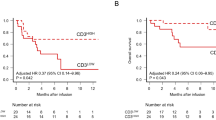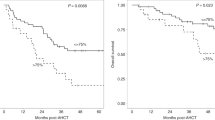Abstract
A specific predictor during routine follow-up to ascertain risk for relapse after standard chemotherapy in non-Hodgkin's lymphoma (NHL) has not been identified. Thus, we studied absolute lymphocyte count (ALC) as a marker of poststandard chemotherapy (rituximab, cyclophosphamide, adriamycin, vincristine and prednisone (R-CHOP)) NHL relapse in patients with diffuse large B-cell lymphoma (DLBCL). ALC was obtained at the time of confirmed relapse and at last follow-up. From 2000 until 2006, 149 consecutive DLBCL patients, originally diagnosed, treated with R-CHOP and followed up at Mayo Clinic, Rochester, were included in this study. Patients at last follow-up without relapse (N=112) had a higher ALC compared with those with relapsed lymphoma ((N=37) median ALC × 109/l of 1.43 (range: 0.33–4.0) versus 0.67 (range: 0.18–1.98), P<0.0001, respectively). ALC at the time of confirmed relapse was a strong predictor for relapse with an area under the curve =0.91 (P<0.0001). An ALC <0.96 × 109/l at the time of confirmed relapse had a positive predictive value of 72% and a positive likelihood ratio of 7.4 to predict relapse after R-CHOP in DLBCL. Patients with an ALC⩾0.96 × 109/l (N=103) had a cumulative incidence of relapse of 6 versus 79% with an ALC <0.96 × 109/l (N=46) (P<0.0001). This study suggests that lymphopenia measured by ALC can be used as a marker to assess risk of DLBCL relapse during routine follow-up after standard chemotherapy.
This is a preview of subscription content, access via your institution
Access options
Subscribe to this journal
Receive 12 print issues and online access
$259.00 per year
only $21.58 per issue
Buy this article
- Purchase on Springer Link
- Instant access to full article PDF
Prices may be subject to local taxes which are calculated during checkout






Similar content being viewed by others
References
National Comprehensive Cancer Network (NCCN). Diffuse large B-cell lymphoma. Practice Guidelines in Oncology-v1.2010.
Tilly H, Dreying M . Diffuse large B-cell non-Hodgkin's lymphoma: ESMO clinical recommendations for diagnosis, treatment and follow-up. Ann Oncol 2009; 20 (suppl 4): iv110–iv112: doi:10.1093/annonc/mdp145.
Cheson BD, Pfistner B, Juweid ME, Gascoyne RD, Specht L, Horning SJ et al. Revised response criteria for malignant lymphoma. J Clin Oncol 2007; 25: 579–586.
Schoulten HC . Response evaluation and long term follow-up. Ann Oncol 2007; 18 (Suppl 1): i33–i36.
Shipp MA, Harrington DP, Anderson JR, Armitage JO, Bonadonna G, Brittinger G et al. A predictive model for aggressive NHL: The International non-Hodgkin's Lymphoma Prognostic Factors Project. N Engl J Med 1993; 329: 987–994.
Rosenwald A, Wright G, Chan WC, Connors JM, Campo E, Fisher RJ et al. The use of molecular profiling to predict survival after chemotherapy for diffuse large B-cell lymphoma. N Engl J Med 2002; 346: 1937–1947.
Alizadeh AA, Eisen MB, Davis RE, Ma C, Lossos IS, Rosenwald A et al. Distinct types of diffuse large B-cell lymphoma identified by gene expression profiling. Nature 2000; 403: 503–511.
Weeks JC, Yeap BY, Canellos GP, Shipp MA . Value of follow-up procedures in patients with large-cell lymphoma who achieves a complete remission. J Clin Oncol 1991; 9: 1196–1203.
Cox MC, Nofroni I, LaVerde G, Ferrari A, Amodeo R, Tatarelli C et al. Absolute lymphocyte count is a prognostic factor for diffuse large B-cell lymphoma. Br J Haematol 2008; 141: 265–268.
Cox MC, Nofroni I, Ruco L, Amodeo R, Ferrari A, La Verde G et al. Low absolute lymphocyte count is a poor prognostic factor in diffuse large B-cell lymphoma. Leuk Lymphoma 2008; 49: 745–751.
Oki Y, Yamamoto K, Kato H, Kuwatsula Y, Taji H, Kagami Y et al. Low absolute lymphocyte count is a poor prognostic marker in patients with diffuse large B-cell lymphoma and suggests patients survival benefit from rituximab. Eur J Haematol 2008; 81: 448–453.
Cox CJ, Habermann TM, Payne BA, Klee GG, Pierre RV . Evaluation of the Coulter counter model S-Plus IV. Am J Clin Pathol 1985; 84: 297–306.
Gooley TA, Leisenring W, Crowley J, Storer BE . Estimation of failure probabilities in the presence of competing risks: new representation of old estimators. Stat Med 1999; 18: 695–706.
Dignam JJ, Kocherginsky MN . Choice and interpretation of statistical tests used when competing risks are present. J Clin Oncol 2008; 26: 4027–4034.
Ghosh D . Proportional hazards regression for cancer studies. Biometrics 2008; 64: 141–148.
Habermann TM . Posttransplant lymphoproliferative disorders. Cancer Treat Res 2008; 142: 273–292.
Behl D, Ristow K, Markovic SN, Witzig TE, Habermann TM, Colgan JP et al. Absolute lymphocyte count predicts therapeutic efficacy of rituximab therapy in follicular lymphomas. Br J Haematol 2007; 137: 409–415.
Coiffier B, Lepage E, Briere J, Herbrecht R, Tilly H, Bouabdallah R et al. CHOP chemotherapy plus rituximab compared with CHOP alone in elderly patients with diffuse large B-cell lymphoma. N Engl J Med 2002; 346: 235–242.
Habermann TM, Weler EA, Morrison VA, Gascoyne RD, Cassileth PA, Cohn JB et al. Rituximab-CHOP versus CHOP alone or with maintenance rituximab in older patients with diffuse large B-cell lymphoma. J Clin Oncol 2006; 24: 3121–3127.
Author information
Authors and Affiliations
Corresponding author
Ethics declarations
Competing interests
The authors declare no conflict of interest.
Rights and permissions
About this article
Cite this article
Porrata, L., Rsitow, K., Inwards, D. et al. Lymphopenia assessed during routine follow-up after immunochemotherapy (R-CHOP) is a risk factor for predicting relapse in patients with diffuse large B-cell lymphoma. Leukemia 24, 1343–1349 (2010). https://doi.org/10.1038/leu.2010.108
Received:
Accepted:
Published:
Issue Date:
DOI: https://doi.org/10.1038/leu.2010.108
Keywords
This article is cited by
-
Prognostic impact of absolute peripheral blood NK cell count after four cycles of R-CHOP-like regimen treatment in patients with diffuse large B cell lymphoma
Clinical and Experimental Medicine (2023)
-
Prognostic role of neutrophil-to-lymphocyte ratio in diffuse large B cell lymphoma patients: an updated dose–response meta-analysis
Cancer Cell International (2018)
-
Routine blood investigations have limited utility in surveillance of aggressive lymphoma in asymptomatic patients in complete remission
British Journal of Cancer (2018)
-
Prognostic relevance of lymphocytopenia, monocytopenia and lymphocyte-to-monocyte ratio in primary myelodysplastic syndromes: a single center experience in 889 patients
Blood Cancer Journal (2017)
-
Low absolute peripheral blood CD4+ T-cell count predicts poor prognosis in R-CHOP-treated patients with diffuse large B-cell lymphoma
Blood Cancer Journal (2017)



